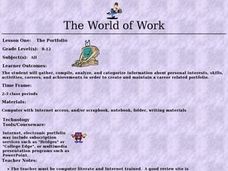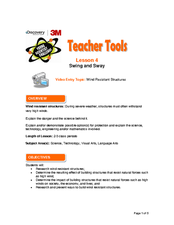Curated OER
Creepy Crawlies
Second graders study the world of insects. They join Greenpatch Kids, an organization of young people who are interested in nature and want to protect our environment. In addition, the students assess use of technology as a valuable...
Curated OER
Dig In
Students explore harvest festivals. In this harvesting lesson, students view photos of Christian harvest festivals and Jewish harvest festivals. Students plan a harvest festival within their own school.
Curated OER
Water-The Liquid Gold
Learners investigate the necessity of water for the survival of plants, animals, and people. They explore the affect that water has on human and natural environments through literature, field trips, and discussions.
Curated OER
What's Out There? Space Shuttle Exploration and Simulation
Learners simulate life in space aboard the space shuttle. In this space exploration lesson, students work in small groups to model life aboard the space shuttle. Each student is given a job, conducts Internet research on space, and...
Curated OER
Are You My Little Peanut?
Fourth graders explore the mass and length of peanuts by pretending to parent a peanut. In this mode, median and range lesson students graph their measurements and then use them to find the mode, median and range. Students discuss peanut...
Curated OER
ABC and 1-2-3 Farming
Students demonstrate how to alphabetize animal names. In this word study lesson plan, students identify animals that live on the farm and conduct a favorite farm animal survey. Students order animal pictures in alphabetical order.
Curated OER
How Communication Technologies Affect People
Third graders complete a worksheet, first with known information, and then with researched information. They create a PowerPoint, video, or radio broadcast to convey the results of their research. They learn to use a graphic organizer to...
Curated OER
The World of Work: The Portfolio
Students compile information to include in their career portfolio. In this portfolio lesson, students view example portfolios using the given website and identify the portfolio components. Students gather and compile artifacts for their...
Museum of Tolerance
Developing Media Literacy
To protect young people from questionable content, many schools limit access. This resource suggests that because learners can so readily avail themselves to unrestricted Internet access, it is vital for 21st century learners to develop...
Channel Islands Film
Cache: Lesson Plan 1 - Grades 9-12
Archaeologists have discovered a cache of Native American relics. They want to preserve these relics by removing them from the rapidly eroding site to a lab where they can be studied. Native American traditions demand that the items be...
Channel Islands Film
Cache: Lesson Plan 2 - Grades 4-6
Class members will dig this activity that has them trying their hand at recovering artifacts. Groups are assigned a section of a sandbox, carefully uncover the artifacts in their section, and then develop theories about who might have...
Curated OER
Fracking: Positive or Negative Impact?
Your teenagers may have heard of fracking, but do they really know what it is? And could they debate the benefits and risks? Educate your environmental science class with a lesson about hydraulic fracturing, non-renewable energy sources,...
Channel Islands Film
Island Cattle Ranching
Is cattle ranching on Santa Rosa island viable or non-viable? Rather than focusing on the issues of the transition of Santa Rosa island from a privately owned island cattle ranch to a national park, class members are asked to consider if...
Channel Islands Film
Island Rotation: Lesson Plan 2
Why are Torrey pines only found in La Jolla, California and on Santa Rosa Island? Class members examine images of Torrey pines from these two locations, noting the similarities and differences, and then develop a demonstration model that...
Curated OER
Famous Black Americans
Students recognize famous Black Americans and their roles in America's society. They create a database and slideshow presenting famous Black Americans and relevant facts of their lives.
Curated OER
Karst Topography
Students observe a movie about karst topography over the Internet and note nonpoint source pollution. They discuss ways to manage pollution and their experiences with any polltion sources.
Curated OER
Math/Technology: Measuring Objects
Third graders create Powerpoint templates of pictures they have taken. Using both standard and metrric measurement units, they describe what units of measurement they would use for each object. In the computer lab, they work in pairs to...
Curated OER
Welcome to Leonard Bernstein's New York
Students study the life and musical work of Leonard Bernstein. They examine the history of New York City using three Broadway musicals in a web based lesson. They create a portrayal of their own town in this multi-lesson activity.
Curated OER
Math/Technology: Coin Combos
Second graders identify coin combinations needed to purchase items under a dollar. Using Kidspiration, they demonstrate three ways to purchase a pizza slice for 96 cents and choose an item which cost less than a dollar for other to...
Curated OER
Time Out for Timelines
First graders, while in the computer lab, manipulate events onto a calendar created in Publisher and then create a time line of important dates. They place their important dates in the correct month on a calendar and then sequence the...
Curated OER
Let's Build a City In the Solar System
Sixth graders explore the solar system. Using the Internet, 6th graders gather information about planets in our solar system. Students participate in an activity to determine where they should build the first city in space. They create a...
Curated OER
Funky Food Farm
Students research about ways to keep food from spoiling. In this health science lesson, students design an experiment to keep the ice cubes from melting. They present their designs and results in class.
Curated OER
Sun Smarts
Students discuss the harmful effects of UV radiation. In this health science lesson, students examine the . They suggest ways to protect themselves against UV.
Curated OER
Swing and Sway
Middle schoolers research the destructive force of the wind. In this science lesson, students design and build a wind resistant structure. They explain why they chose a particular design and present their structure in class.

























